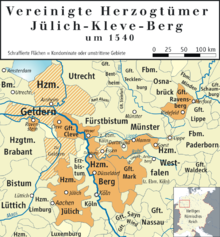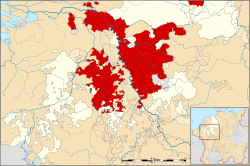- United Duchies of Jülich-Cleves-Berg
-
"Duchy of Jülich-Berg" redirects here. For a list of rulers of the Duchy of Jülich-Berg, see Duchy of Berg.
United Duchies of Jülich-Cleves-Berg
Vereinigte Herzogtümer Jülich-Kleve-Berg (de)
Verenigde Hertogdommen Gulik-Kleef-Berg (nl)State of the Holy Roman Empire ↓ 1521–1614  →
→
 →
→Coat of arms
Map of the Lower Rhenish–Westphalian Circle around 1560,
United Duchies of Jülich-Cleves-Berg highlighted in redCapital Düsseldorf Language(s) South Guelderish, Limburgish Government Principality Historical era Middle Ages - Cleves and Mark
inherited by
Duke of Jülich-Berg
1521- Partitioned at Xanten 12 November 1614 Preceded by Succeeded by 
Duchy of Berg 
Duchy of Cleves 
Duchy of Jülich 
County of Mark 
County of Ravensberg Margraviate of Brandenburg 
Palatinate-Neuburg 
Today part of  Germany
Germany
 Netherlands
Netherlands map of Jülich-Cleves-Berg including the province of Gelderland (around 1540)
map of Jülich-Cleves-Berg including the province of Gelderland (around 1540)
Jülich-Cleves-Berg was the name of two former territories across the modern German state of North Rhine-Westphalia and the modern Dutch province of Gelderland. From 1521 to 1666, the territory was a combination of states in personal union, all reichsfrei territories of the Holy Roman Empire. The name was resurrected after the Congress of Vienna for a short-lived province of the Kingdom of Prussia between 1815 and 1822.
Contents
History
The United Duchies of Jülich-Cleves-Berg was a combination of states of the Holy Roman Empire. The duchies of Jülich and Berg united in 1423. Nearly a century later, in 1521, these two duchies, along with the county of Ravensberg, fell extinct, with only the last duke's daughter Maria von Geldern left to inherit; under Salic law, women could only hold property through a husband or guardian, so the territories passed to her husband — and distant relative — John III, Duke of Cleves and Mark as a result of their strategic marriage in 1509. These united duchies controlled most of the present-day North Rhine-Westphalia that was not within the ecclesiastical territories of Electoral Cologne and Münster.
Only a century after John III's marriage, however, the united ducal line fell extinct, prompting a war over the succession to the territories after the death of John III's grandson, duke John-William, without issue. Whilst the dukes, inspired by the humanism of Desiderius Erasmus, had managed to bear a "via media" between the confessional disputes ensuing from the Protestant Reformation, the heirs of the last duke's two eldest sisters were on opposite sides of the divide. The situation was further complicated by acquisitive desires of Emperor Rudolph II and the Wettin dukes of Saxony — the former particularly worrying to Henry IV of France and the Dutch Republic, who feared any strengthening of the Habsburg Netherlands.
The Lutheran Anna of Prussia was married to John Sigismund, Elector of Brandenburg, whereas Roman Catholic Anna of Cleves was married to Philip Louis, Count Palatine of Neuburg. As a result, after the War of the Jülich Succession (one of the precursors to the Thirty Years' War) was settled at Xanten, the Protestant territories (Cleves, Mark and Ravensburg) passed to Brandenburg-Prussia with the Catholic lands (Jülich and Berge) being awarded to the Palatinate-Neuburg. Unfortunately, years of being trampled by armies had destroyed much of the lands' wealth that had been so renowned under John William's father, William the Rich.
Philip Louis' grandson Philip William became Elector Palatine in 1685, with the Bergish capital becoming the seat of the Electoral Palatinate, until the line inherited Bavaria in 1777. In 1701, the Margrave-Electors of Brandenburg became Kings in Prussia; with Cleves-Mark as their first possession in western Germany, it was the seed of the future Prussian Rhineland.
Dukes of Jülich-Cleves-Berg, House of La Marck
- 1521–1539: John III, Duke of Cleves
- 1539–1592: William the Rich
- 1592–1609: John William
See also
References
- This article incorporates information from the equivalent article on the German Wikipedia.
Categories:- Former principalities
- Former polities in the Netherlands
- States of the Holy Roman Empire
- States and territories established in 1521
- States and territories disestablished in 1614
- Lower Rhenish-Westphalian Circle
- History of Düsseldorf
Wikimedia Foundation. 2010.


